Viruses exist on the edge between life and death. They are acellular, or nonliving, agents that require living organisms as hosts to survive. This is unlike other pathogens, such as bacteria or fungi, which are cellular organisms that can survive independently of another living organism. Viruses are truly a twisted spectacle of nature, for they aren’t even a full cells. They are actually smaller than bacteria and are usually only made up of a few genes.
All viruses operate under the same objective and roughly follow the same five steps:
- Infect Host
- Avoid Immune Cells
- Travel to Target Cells
- Multiply
- Repeat
The actual mechanisms of these five steps are far more complex, but for the sake of simplicity, we’ll leave it at that. Bottom line is that a virus’ main goal is to infect its living host and wreak havoc amongst other cells.
There are currently only a handful of cannabis viruses that have been studied and published about. These viruses will be the focal point of this article and include:
- Hop Latent Viroid
- Lettuce Chlorosis Virus
- Cannabis Cryptic Virus
- Tobacco Mosaic Virus
- Beet Curly Top Virus
To assist in my knowledge about this matter, we interviewed Liam Kane, R&D Scientist at Medicinal Genomics, about each virus and its role in cannabis. Liam has designed and internally validated all of Medicinal Genomics’ cannabis virus assays, including but not limited to: the primer design, testing with various Master Mixes, and an assay optimization process. He also helped design Beta test experiments with other labs, in which he compiled the data and adjusted the protocols accordingly.
So let’s dive right in, at the top 5 viruses to watch out for in your cannabis grow:
1. Hop Latent Viroid
Hop latent viroid (HLVd) is an RNA-based pathogen that only affects plants. HLVd is classified as a viroid, not a virus, simply because it is missing a protein coat. As the name also denotes, HLVd was first discovered in hops but has since been identified as a threat to cannabis plants as well. In fact, Liam believes that it’s “certainly the most common cannabis viroid/virus observed in the field”.
In cannabis plants, HLVd causes a phenomenon called “Dudding”. Dudding is an informal term that is used to describe the following symptoms:
- Loss of vigor
- Stunted growth
- Reduction in yield
- Potency loss in cannabinoids
- Changes in morphology
Due to these less-than-desirable effects, it is important to screen cannabis plants early on to ensure that HLVd cannot further contaminate and spread to more of the grow. Hop Latent Viroid can be found in the flower or bud of the plant but can also go undetected in the root system of the cannabis plant. That’s why it’s important to test the roots and perform HLVd root testing of the cannabis plant and not just the flower or bud.
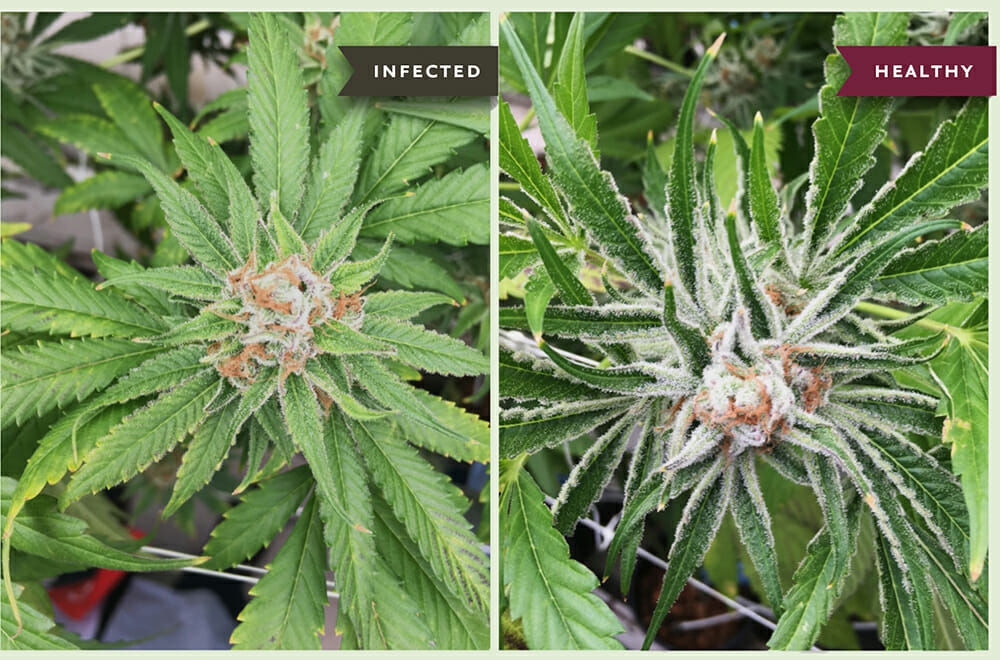
So… what does an early-on screening process look like?
Liam describes the screening process as such:
“Once you get the leaves past the cotyledons, so once the real mature cannabis leaves [arise], you can take a hole punch and screen it using [Medicinal Genomics’] PathoSEEK® Cannabis Virus Multiplex Detection Assay and our extraction protocol. [Which] is particularly important if you are getting it from clones from outside grow – you’d be able to recognize right away if it was infected with Hop Latent Viroid; as well as the others, because they’re multiplexed into each other.”
Liam also mentioned that “the pathology tends to occur later in the plant’s life. So if you’re growing from a clone, or a seed, or whatever, and it is infected, usually you can’t tell until later in the flowering process”.
This latent nature of HLVd makes it a challenging pathogen for two reasons:
- It’s difficult to detect
- It’s troublesome to fully eradicate
A common scenario in an infected cannabis grow is that while the plants may look and seem healthy, they are merely just asymptomatic. As a result, many growers are not aware that the pathogen is present and actively infecting other plants in the garden.
In order to prevent any of this from happening, Liam highly recommends testing mother plants:
“We advocate testing mother plants – often; because if your mother plant gets infected, it’s a great way to propagate that through your grow – versus if a clone of that mother gets infected, you can just kill the clone without losing its genetics”.
2. Lettuce Chlorosis Virus
Lettuce Chlorosis Virus (LCV) is an RNA-based virus that is frequently found in lettuce but has also been found in cannabis as well.
The term chlorosis refers to leaves turning yellow due to a lack of chlorophyll. When a cannabis plant is infected by LCV, it leads to failure to thrive. This failure is caused by the plant not being able to absorb as much sunlight as it would typically need, therefore its growth is significantly restricted.
Liam says that, “in [his] opinion, Lettuce Chlorosis Virus tends to have more dramatic impacts on the plant itself. It looks sick. Versus, Hop Latent Viroid can be [that] this plant just didn’t grow nicely – it’s small; it’s runty; [the] buds aren’t very mature.”
LCV and HLVd can exhibit similar symptoms, Liam mentioned. He went on to say that “the Lettuce Chlorosis Virus tends to be a little more obvious in [vegetation]. But you know, admittedly, across the board, these are very early days in our virus research as an industry”.
Liam mentioned that these viruses have been around for a while, but nobody has been really looking for them in cannabis until recently.
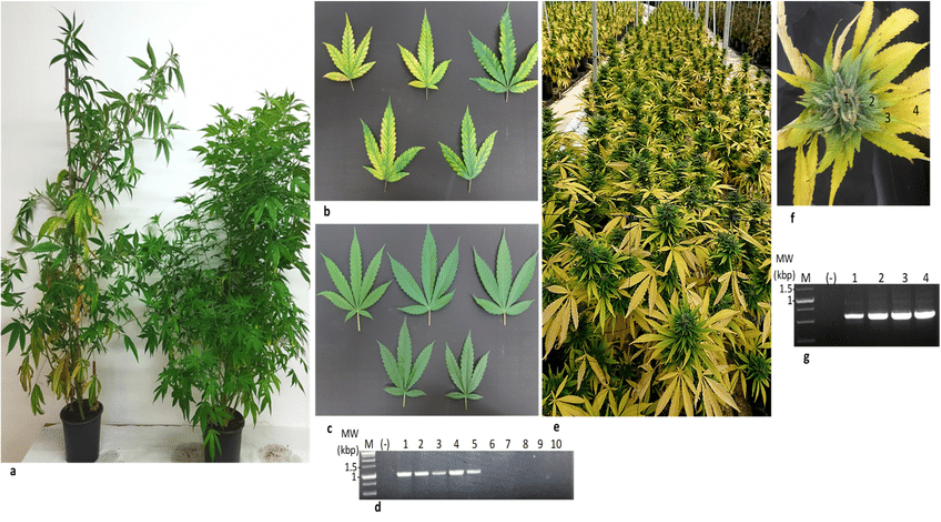
DOI: http://dx.doi.org/10.3390/v11090802
What do you mean by looking for it?
Liam explains, “Well, it’s kind of like COVID testing. You could be asymptomatic and not show any symptoms, or you could be slightly run down, not have any symptoms, and think you’re fine, and then all of a sudden you turn around and get a COVID test and test positive.”
“Previously, I suspect these viruses were out in the cannabis population, but nobody was testing for the presence of any of these viruses, and so they say things like, my plant isn’t growing right – it must just be a weird thing with this plant. When in fact, if they had gone and surveyed the RNA they’d realized there is a viral infection. So people have just started surveying for viruses relatively recently; and I think we, internally, were surprised by the distribution of some of these because we get a lot of [plants] that are testing positive; and it tends to be a surprise in some respects.”
3. Cannabis Cryptic Virus
Cannabis Cryptic Virus (CCV) is another RNA-based virus. The inclusion of the word, ‘cryptic’ in its name was no mistake, for this virus is quite the enigma. What’s so interesting about CCV’s mysterious nature is that “it doesn’t seem to cause any actual pathology in the plant”, stated Liam. CCV is an atypical virus in the sense of its symptoms and effects.
Liam went on to explain that, “there seems to be some anecdotal evidence that in coinfections it might add pathology. You know, when [Cannabis Cryptic Virus] is there with Hop Latent Virus or Lettuce Chlorosis Virus, it may slightly alter the ways those are working – but it’s pretty anecdotal. So, admittedly, Cannabis Cryptic Virus is kind of the ‘Red Headed Step Child’…”.
Meaning that CCV is most commonly detected in the presence of another virus, and can add or alter viral symptoms in that sense.
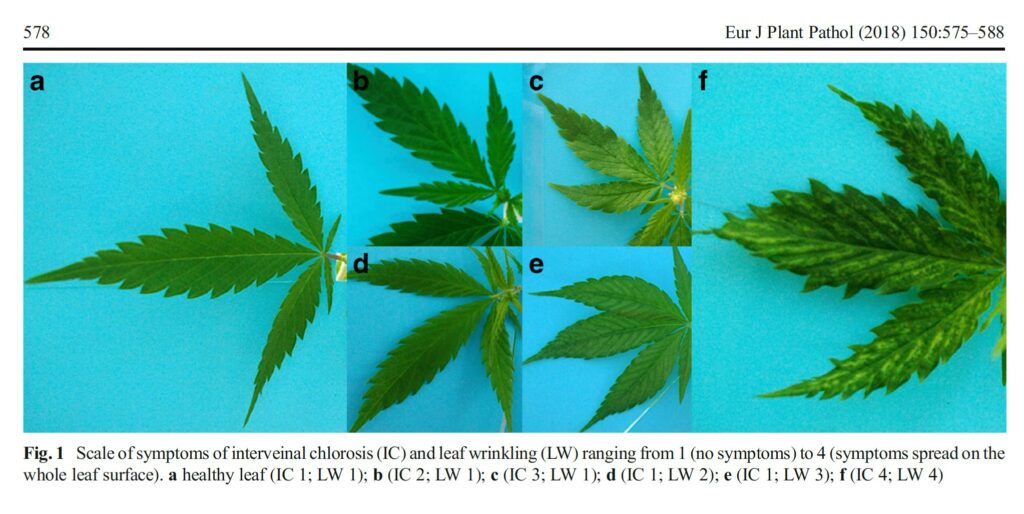
DOI: https://doi.org/10.1007/s10658-017-1301-y
Liam said that “[they’re] hopeful to see more work on that front – to figure out if [CCV is] actually something worth surveying, or not; [but] it’s too preliminary to tell right now”.
It has been discovered that CCV can be transmitted through seeds, meaning that this pathogen is able to spread from seeds to seedlings, to plants in the next generation. This type of viral spread is referred to as ‘vertical transmission’. In order to prevent the vertical transmission of CCV, cannabis cultivators are strongly advised to screen their crop before cross-breeding.
4. Tobacco Mosaic Virus
Tobacco Mosaic Virus (TMV) is an RNA-based virus that infects a wide range of plant species, especially tobacco plants. TMV has been around for a while, having first been discovered in the 1800s.
Most notably, TMV causes mosaicism of plant leaves. In other words, TMV causes spontaneous mutations in the genes of certain cells, which then causes an array of visual disorders in plants, Liam describes mosaicism as “weird splotches of yellow and green” in plants. He also notes that mosaicism “alters the photosynthetic capability of those leaves”.
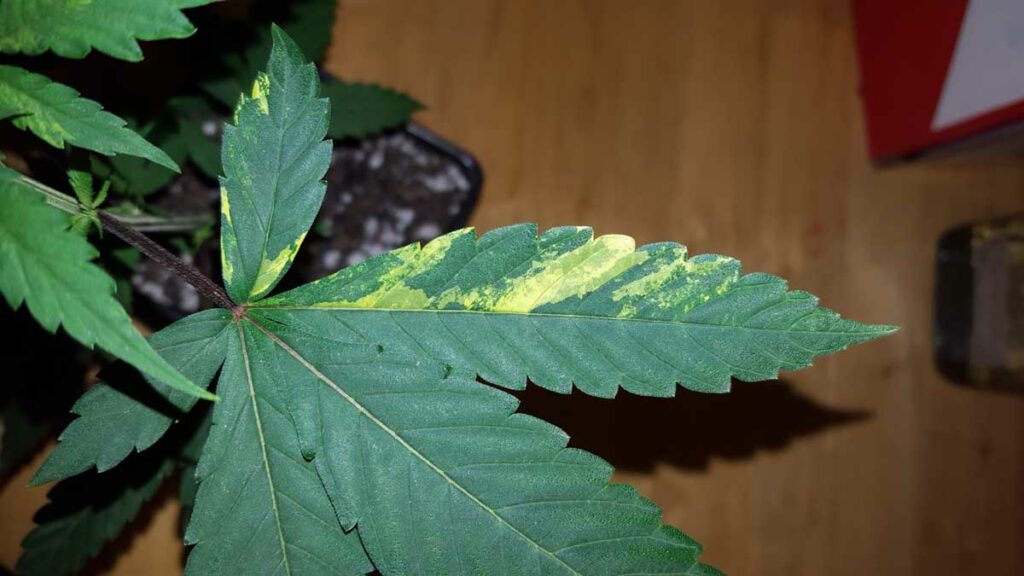
Symptoms may vary with the species of plant infected by TMV, but here are the most common symptoms observed and associated in cannabis plants:
- Mosaic, mottling leaves
- Necrosis
- Stunting
- Curling of leaves
- Yellow of plant tissues
- Reduction of yield and potency
Liam goes on to say that “Tobacco Mosaic Virus is very stable and very easy to transmit. [Thus], it is a major concern for grows because, you know, you [could] get someone that smokes a cigarette and contaminates the entire grow – theoretically”.
5. Beet Curly Top Virus
Last but not least is Beet Curly Top Virus (BCTV). Unlike all the other viruses mentioned thus far, BCTV is a DNA based virus and is most commonly found in sugar beets.
Liam describes BCTV as such:
“As [its] name would suggest, the Beet Curly Top Virus causes the leaves to curl in on themselves. Again, it alters the photosynthetic capabilities of the plant, which leads to less growth [and] less yield. It’s very funny to see because the leaves will almost roll up on themselves into little cones, it seems like. So it’s pretty dramatic”.
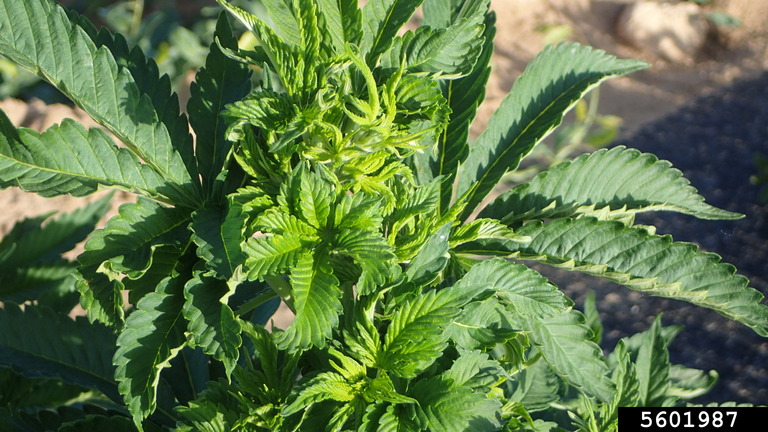
BCTV can only be spread via beet leafhopper insects. These insects pick up the virus while feeding on infected plants, and in turn, transfer it to other plants once they move to the next. BCTV does not cause harm to the insects. Due to the fact of the innate mobility of this virus, it can become difficult for cannabis cultivators to eradicate BCTV.
How are these viruses detected?
Liam explains that “these viruses we are dealing with are RNA-based viruses. So what you would do is take a plant that is sickly, or you have a reason to suspect it has a virus, and extract the RNA from it. Isolate that RNA. And then there are various methods you can go through to focus the RNA – like something called ribo depletion – so you get rid of a lot of the plant’s background RNA, and then you sequence the remainder to see whatever RNA transcripts are floating around; and that’s where you would discover any other viruses. This is how they discovered novel viruses in humans. Or how they discover new variants in COVID, for example. They sequence the RNA of, whatever the sample is, and then look for those new viruses and new variants”.
He continued, “So across the board, I would say RNA sequencing for viruses is very important; because as it stands right now, we don’t really know the viral load across different plants for different viruses, or how they spread within the [cannabis] plants. So, you know, for Hop Latent Viroid, the viral load seems to be high across different tissues we’ve surveyed – we’ve detected it in roots, stems, flowers, and leaves. But to understand how the virus is actually infecting the plant, and whether there’s differential viral expression in different tissues would be very valuable. And that just requires deep RNA sequencing work. And again, that’s how you would discover new viruses in cannabis. So that’s something we hope to pursue at some point, but unfortunately, everyone who thinks they have something novel ends up [testing positive] on one of our other assays. A lot of people say, ‘I don’t know what’s going on. I have this plant that seems to be sick and its symptoms seem weird’, so we start on one of our 5 virus assays and it very commonly will pop on one of those”.
In conclusion…
- Cannabis viruses are still in the beginning stages of their advancements with being sequenced, studied, and published about.
- Hop Latent Viroid is the most common cannabis viroid/virus observed in cannabis.
- Cannabis growers and cultivators should test their mother plants – often.
- RNA sequencing is necessary to determine and confirm which virus your cannabis crop is infected with.
Sources:
Advancing the Science of Plant Pathology Council



 Modern Canna
Modern Canna